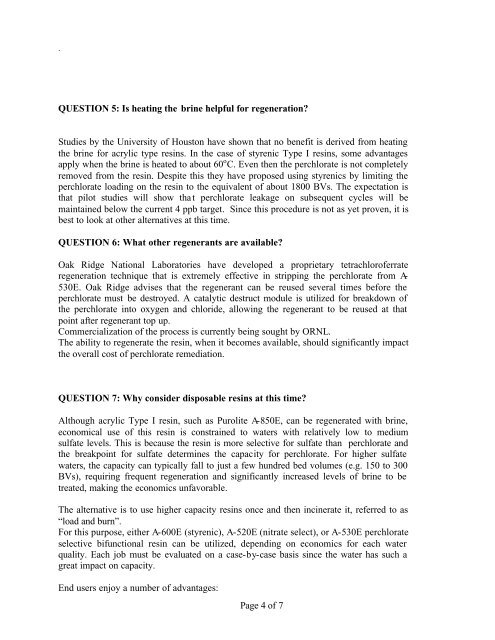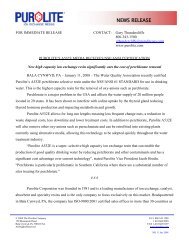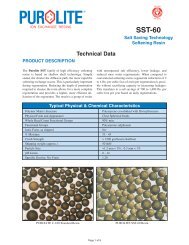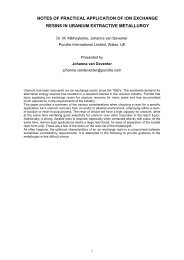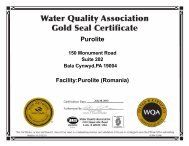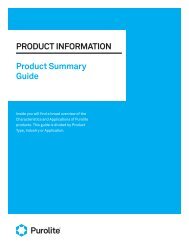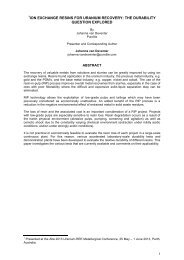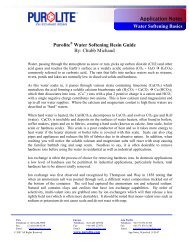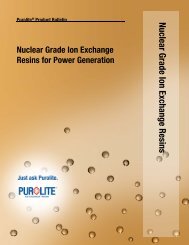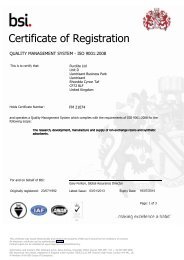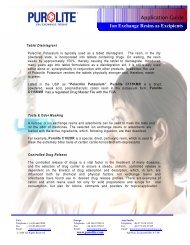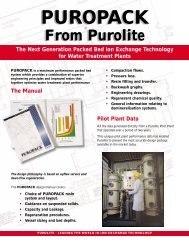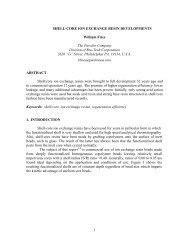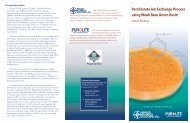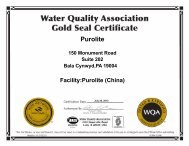Perchlorate Facts for Technology Vendors - Purolite
Perchlorate Facts for Technology Vendors - Purolite
Perchlorate Facts for Technology Vendors - Purolite
You also want an ePaper? Increase the reach of your titles
YUMPU automatically turns print PDFs into web optimized ePapers that Google loves.
.QUESTION 5: Is heating the brine helpful <strong>for</strong> regeneration?Studies by the University of Houston have shown that no benefit is derived from heatingthe brine <strong>for</strong> acrylic type resins. In the case of styrenic Type I resins, some advantagesapply when the brine is heated to about 60 o C. Even then the perchlorate is not completelyremoved from the resin. Despite this they have proposed using styrenics by limiting theperchlorate loading on the resin to the equivalent of about 1800 BVs. The expectation isthat pilot studies will show that perchlorate leakage on subsequent cycles will bemaintained below the current 4 ppb target. Since this procedure is not as yet proven, it isbest to look at other alternatives at this time.QUESTION 6: What other regenerants are available?Oak Ridge National Laboratories have developed a proprietary tetrachloroferrateregeneration technique that is extremely effective in stripping the perchlorate from A-530E. Oak Ridge advises that the regenerant can be reused several times be<strong>for</strong>e theperchlorate must be destroyed. A catalytic destruct module is utilized <strong>for</strong> breakdown ofthe perchlorate into oxygen and chloride, allowing the regenerant to be reused at thatpoint after regenerant top up.Commercialization of the process is currently being sought by ORNL.The ability to regenerate the resin, when it becomes available, should significantly impactthe overall cost of perchlorate remediation.QUESTION 7: Why consider disposable resins at this time?Although acrylic Type I resin, such as <strong>Purolite</strong> A-850E, can be regenerated with brine,economical use of this resin is constrained to waters with relatively low to mediumsulfate levels. This is because the resin is more selective <strong>for</strong> sulfate than perchlorate andthe breakpoint <strong>for</strong> sulfate determines the capacity <strong>for</strong> perchlorate. For higher sulfatewaters, the capacity can typically fall to just a few hundred bed volumes (e.g. 150 to 300BVs), requiring frequent regeneration and significantly increased levels of brine to betreated, making the economics unfavorable.The alternative is to use higher capacity resins once and then incinerate it, referred to as“load and burn”.For this purpose, either A-600E (styrenic), A-520E (nitrate select), or A-530E perchlorateselective bifunctional resin can be utilized, depending on economics <strong>for</strong> each waterquality. Each job must be evaluated on a case-by-case basis since the water has such agreat impact on capacity.End users enjoy a number of advantages:Page 4 of 7


